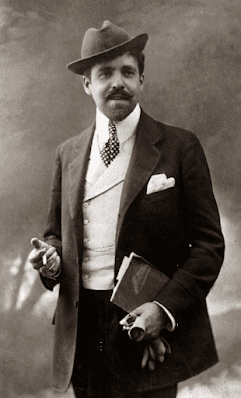 |
| Reynaldo Hahn in 1906 |
Ravel, Fauré, Lili Boulanger, Saint-Saens, Hahn: Piano Quartet; Kaleidoscope Chamber Collective; Wigmore Hall
Reviewed 26 January 2025
Reynaldo Hahn’s Piano Quartet undoubtedly looks back, so this programme took that as its cue to transport us to Belle Époque Paris in a recital full of engaging elegance, charm and real passion
Personally charming and possessed of an engaging voice, Reynaldo Hahn fitted ideally into the salons of Belle Époque Paris. He wrote music with a fluency and style which makes it easy to not take his talent entirely seriously. He fought bravely in the First World War and was awarded the Croix de Guerre. Afterwards it was as if he continued to carry the perfume of the Belle Époque in his music and the works he wrote in the 1920s, 1930s and 1940s remain a world away from the Paris of Les Six, the jazz age and Modernism.
We know the songs and perhaps one or two of the operas, but the rest of his large output remains substantially unexplored. the Kaleidoscope Chamber Collective has recorded a disc of Reynaldo Hahn’s music for Chandos, bringing together his Piano Quintet (of 1922) and the later Piano Quartet with arrangements of a selection of songs.
In part, as a celebration of the imminent release of the disc, the Kaleidoscope Chamber Collective (Tom Poster, piano, Elena Urioste, violin, Savitri Grier, violin, Rosalind Ventris, viola, Laura van der Heijden, cello) placed Reynaldo Hahn’s Piano Quintet at the centre of their morning concert at Wigmore Hall on Sunday 26 January 2025. With the deliberate intention of evoking those Belle Époque salons, the rest of the programme consisted of music by Ravel, Fauré, Lili Boulanger and Saint-Saens.
The beautifully conceived programme expanded towards Hahn’s quintet. With began with pianist Tom Poster, alone on stage, playing Ravel’s Pavane pour une infante défunte and then the number of players gradually increased, a duo, a trio, a quartet and finally the quintet.
Poster brought great elegance and suppleness to Ravel’s little gem, written in 1899 and thus in prime position for the Belle Époque. This was followed by Fauré’s Berceuse from 1879, played by Poster with violinist Savitri Grier. Again elegance and clarity were to the fore with Grier’s sinuous violin line evaporating magically at the end.
Written in 1917/18, Lili Boulanger’s D’un matin de printemps was one of her last works. Here played by Poster, violinist Elena Uriosti and viola player Rosalind Ventris, the piece had all the clarity and elegance of texture of the earlier works but with the addition of Boulanger’s spicier harmonies. Beginning with real nervous energy, the late romantic atmosphere had an appealing edge to it.
Saint-Saens’ Barcarolle, Op. 108 dates originally from 1898 when it was written for the intriguing combination of violin, cello, harmonium and piano, though the composer later arranged it for piano quartet and in this form we heard it at the concert, played by Poster, Grier, Ventris and van der Heijden. It is quite a substantial piece beginning with an evocative piano over rocking strings but then developing into a full romantic texture with nervous energy leading to a real sense of the dance before everything unwound.
Hahn’s Piano Quintet began life in 1917-1918, the first two movements being composed whilst he was mobilised in the First World War. The composer’s own programme note refers to the “vehement effusion of a restless soul, a violent inner tumult, all the symptoms of a feverish passion” in the first movement, and the “profound sadness, contrasting with moments of hope whose glimmer the first violin is repeatedly charged with creating” in the second movement. But the third and final movement was not written until four years later. The work was premiered in 1922 in Paris with Magda Tagliaferro playing the piano.
The first movement plunged straight in with the players giving it an exciting energy and sense of propulsion. But there was also Hahn’s familiar elegance to the melodies and the textures, his writing for piano and strings was never clogged and clotted, despite a richness to the harmonies and you felt that Schumann was somewhere in the back of his mind. The movement rarely eased up, there was always a sense of onward flow sweeping you up until a striking pause moment with solos from individual players, before the recapitulation plunged us back into the onward rush.
The slow movement opened with a melancholy moment for cello and piano that evoked Hahn’s teacher, Massenet, before all three lower strings all joined in. The mood had an elegant darkness to it, a sombreness arising from timbre more than anything else. When Elena Urioste’s first violin finally joined in, it was as a consoling voice in a higher register and this dichotomy was explored throughout, the mood melancholy with moments of consoling violin.
The third movement began all ingratiating elegance, the melody evoking a Fauré song. You wondered how this was going to be the final movement of the piece, but the music developed a robustness and big dramatic moments led to a rush of real nervous energy as we careered to the end.
Hahn’s Piano Quintet is very much a piece out of time, having little in common with what was happening in French music of the period, never mind what was happening in Germany and Austria. But Hahn’s sophisticated technique and secure sense of his own ideas mean that if we take the piece on its own terms, then it is wonderfully engaging. There is no doubt the the Kaleidoscope Chamber Collective feel passionately about the work and their sheer engagement and enjoyment really carried us along.
We had an encore, a little gem from a later France, Edith Piaf’s La vie en rose.
The blog is free, but I’d be delighted if you were to show your appreciation by buying me a coffee.
Elsewhere on this blog
- Anna Dennis’ Susanna was rightly the main focus of John Butt & Dunedin Consort’s involving account of Handel’s neglected oratorio – concert review
- Figures outside a Dacha, with Snowfall, and an Abbey in the Background: from Andrei Tarkovsky’s Nostalghia to Steven Daverson’s new work for orchestra and live electronics – interview
- Beyond Ravel: Mathias Halvorsen comprehensively demonstrates it is well worth exploring Paul Wittgenstein’s commissions – record review
- Johann Christoph Friedrich Bach is undeservedly squashed between his brothers, but this disc shows his music well worth exploring – record review
- ‘They are all gone now, and there isn’t anything more the sea can do to me’: Riders to the Sea – interview
- A glorious, yet sophisticated noise: Handel’s Solomon from Paul McCreesh & Gabrieli with Tim Mead – concert review
- A highly effective synthesis: James Joyce’s The Dead in a dramatised reading from Niamh Cusack with music from The Fourth Choir – review
- Creating a personal world: Ethel Smyth’s earliest orchestral work alongside new pieces by inti figgis-vizueta & Ying Wang – record review
- The complete Walton songs: there aren’t that many but Siân Dicker, Kyrstal Tunnicliffe, Saki Kato certainly make us understand why they are all worthy of attention – record review
- The idea of Greece: Robin Tritschler and Jonathan Ware in a wide-ranging recital from Schubert, Loewe & Wolf to Shostakovich, Dvorak, Berkeley & Ravel – concert review
- Home







